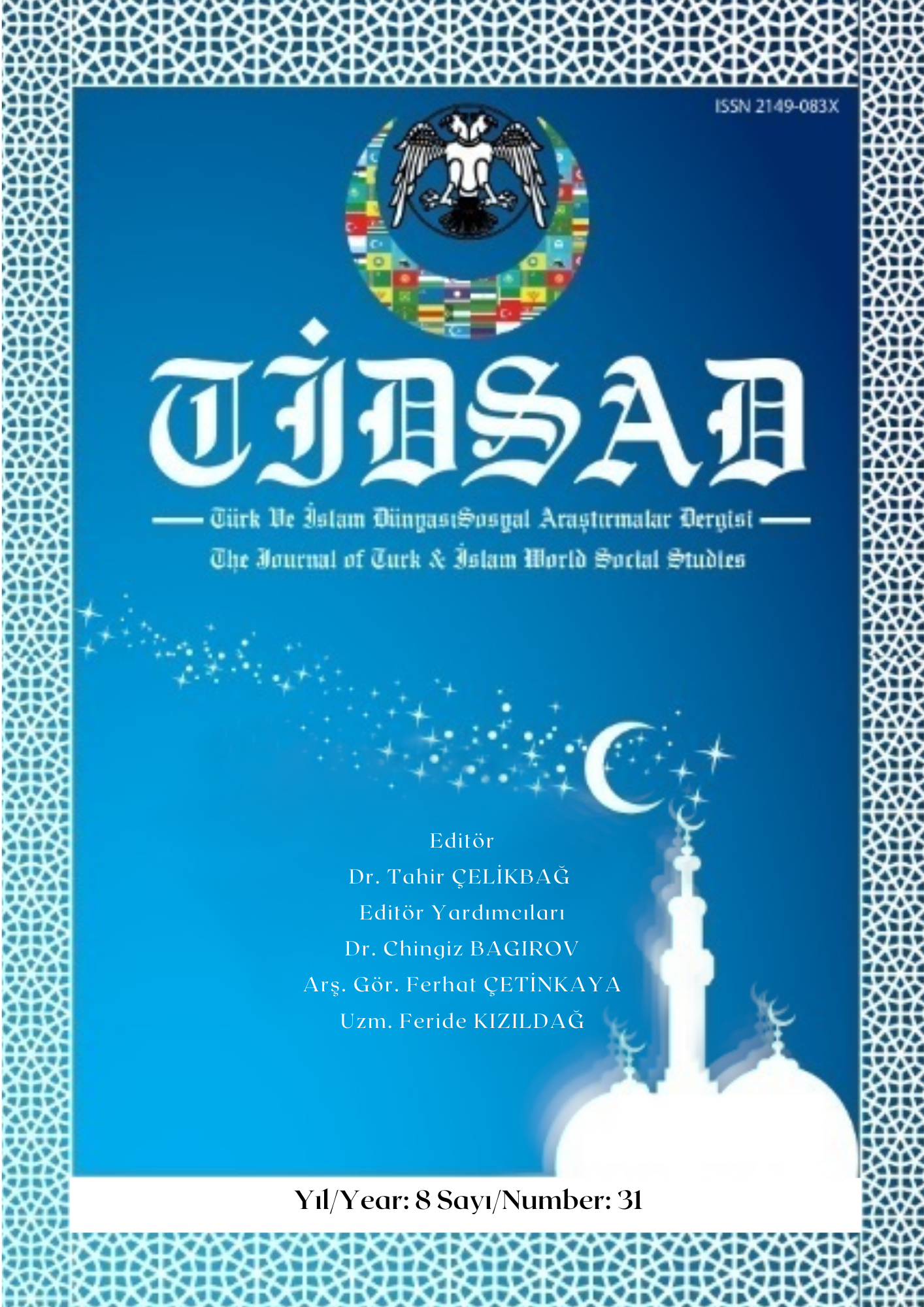Author :
Abstract
Orhun Yazıtları olarak adlandırdığımız Kül Tekin, Bilge Kağan ve Tonyukuk Yazıtlarının yazımında kullanılan Köktürk alfabesinde 4 işaret ikişer ünlüyü göstermek için kullanılır. 31 işaretten 20’si ince ve kalın seslerin ayrımını gösterirken 7 harf yansız harfleri, 4 harf ise ünlü-ünsüz ve ünsüz-ünlü değerinde harfleri göstermektedir. 38 harften oluşan Köktürk alfabesinde üç harf ise çift ünsüzler olarak ifade edilmektedir. Çift ünsüzlerden oluşan harflerle beraber yansız ünsüz kabul edilen işaretler üzerine Türkologlar tarafından yapılan transkripsiyonlar incelendiğinde çeşitli varyantların oluştuğu gözlemlenmektedir. Bu çalışmamızda Orhun Yazıtları üzerine eserler veren Türkologların yazıtlarda kullanılan harfleri nasıl transkribe ettikleri incelenecek ve Uluslararası Fonetik Cemiyetinin tavsiye ettiği IPA alfabesine göre tekrar yorumlanacaktır.
Keywords
Abstract
In the Köktürk alphabet used in the writing of the Kül Tekin (1968: 229-253), Bilge Kagan and Tonyukuk Inscriptions, which we call the Orkhon Inscriptions, 4 signs are used to show two vowels each. 20 out of 31 signs show the distinction thin sounds and low sounds, 7 letters show neutral letters, 4 letters show vowel-consonant and consonant-vowel-valued letters. In the Köktürk alphabet, which consists of 38 letters, three letters are expressed as double consonants. When the transcriptions made by Turcologists on the signs, which are accepted as vowel-consonant and consonant-vowel letters, except for letters consisting of double consonants, various variants are observed. In this study, it will be examined how the Turcologists, who work on the Orkhon Inscriptions and how they transkribe the letters used in the inscriptions, and will be reinterpreted according to the IPA alphabet recommended by the International Phonetic Society.
Keywords
- Abdurrahmanov, G. & Rustamov, A. (1982). Kadimgi Turkiy Til. Ukutuvchi Naşriye- ti,Taşkent.
- Amanzholov, A. S. (2003). History And Theory of Ancient Türkic Writing. Mektep, Almaty.
- Aydarov, G. (1971). Yazık Orhonskih Pamyatnikov Drevnetyurkskoy Pis’mennosti VIII Veka. Alma-Ata: Nauka.
- Aydın, E. (2017). Orhon Yazıtları (Köl Tegin, Bilge Kağan, Tonyukuk, Ongi, Küli Çor). İstan- bul: Bilge Kültür Sanat.
- Bazılhan, N. (2005). Kazakstan Tarihi Turalı Türki Derektemeleri II: Köne Türik Bitiktastarı Men Eskertkişteri (Orhon, Yenisey, Talas). Almatı: “Dayk-Press”.
- Berta, Á. (2010). Sözlerimi İyi Dinleyin: Türk ve Uygur Runik Yazıtlarının Karşılaştırmalı Yayını (Çev. E. Yılmaz). Ankara: Türk Dil Kurumu Yayınları.
- Ercilasun, A.B. (2016). Türk Kağanlığı ve Türk Bengü Taşları. İstanbul: Dergah Yayınları.
- Ergin, M. (1978). Orhun Abideleri, Boğaziçi Yayınları. İstanbul: Boğaziçi Yayınları.
- Gabain, A. (1950). Altürkishce Grammatik. Hamburg.
- Geng, Sh. (2005). Gudai Tujue Wen Bei Ming Yanjiu [Eski Türk Yazıtları Araştırmaları], Bei- jing: Zhongyang Minzu Daxue Chubanshe. 2005. B. 94-223.
- Guzev, V. &, Klyaştornıy, G. (1995). Genel Yazı Nazariyesi Işığında Göktürk Yazısının Men- şei Meselesi. TDAY Belleten, 27-33.
- Hudiyev, N. (2015). Qәdim Türk Yazılı Abidәlәrinin Dili. Bakı.
- Karcaubay, S. (2012). Orhon Muraları: II Kitap (Tüpnüska, Okılımı, Audarması, Tüsinikteme- si). Almatı: Abzal-Ay Baspası.
- Malov, S. (1951). Pamyatniki Drevneturkskoy Pismennosti. İzdatelstvo Moskva: Akademik Nauk.
- Recebov, E. & Memmedov, J. (1993). Orxon Jenisey Abideleri. Bakı: Jazıçı.
- Sıdıkov S. & Konkobayev K. (2001). Bayırkı Türk Jazusuu (VII-X Qılımdar). Bişkek: KTMU.
- Sodikov, K. (2004). Kük Türk Bitiglari: Matn va Uniŋ Tarixiy Talkini, Taşkent: Davlat Şark- şunoslik İnstituti Naşriyeti.
- Şükürlü, Ә. (1993). Qәdim Türk Yazılı Abidәlәrinin Dili, Bakı: Maarif Nәşriyatı.
- Tekin, T. (1968). A Grammar Of Orkhon Turkic. Indiana University, Bloomington.
- Tekin, T. (2010). Orhun Türkçesi Grameri. Ankara: TDK,.
- Vambery, H. (1989). Noten Zu Den Alttürikchen Inschriften Der Mongolei and Sibiriens, Hel- singfors.
- (https://www.internationalphoneticassociation.org/content/full-ipa-chart) Alıntılama tarihi: 01.11.2021.





